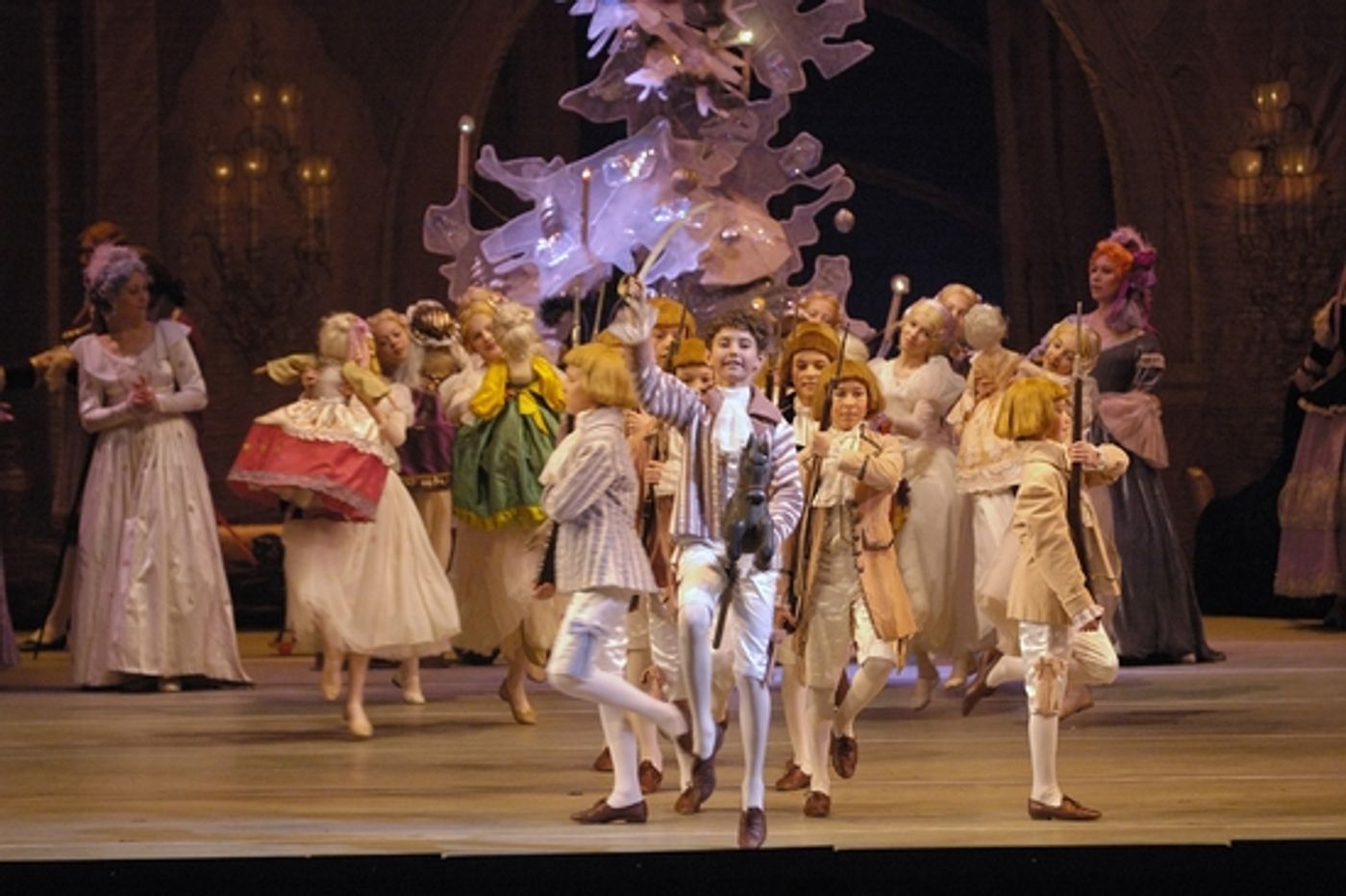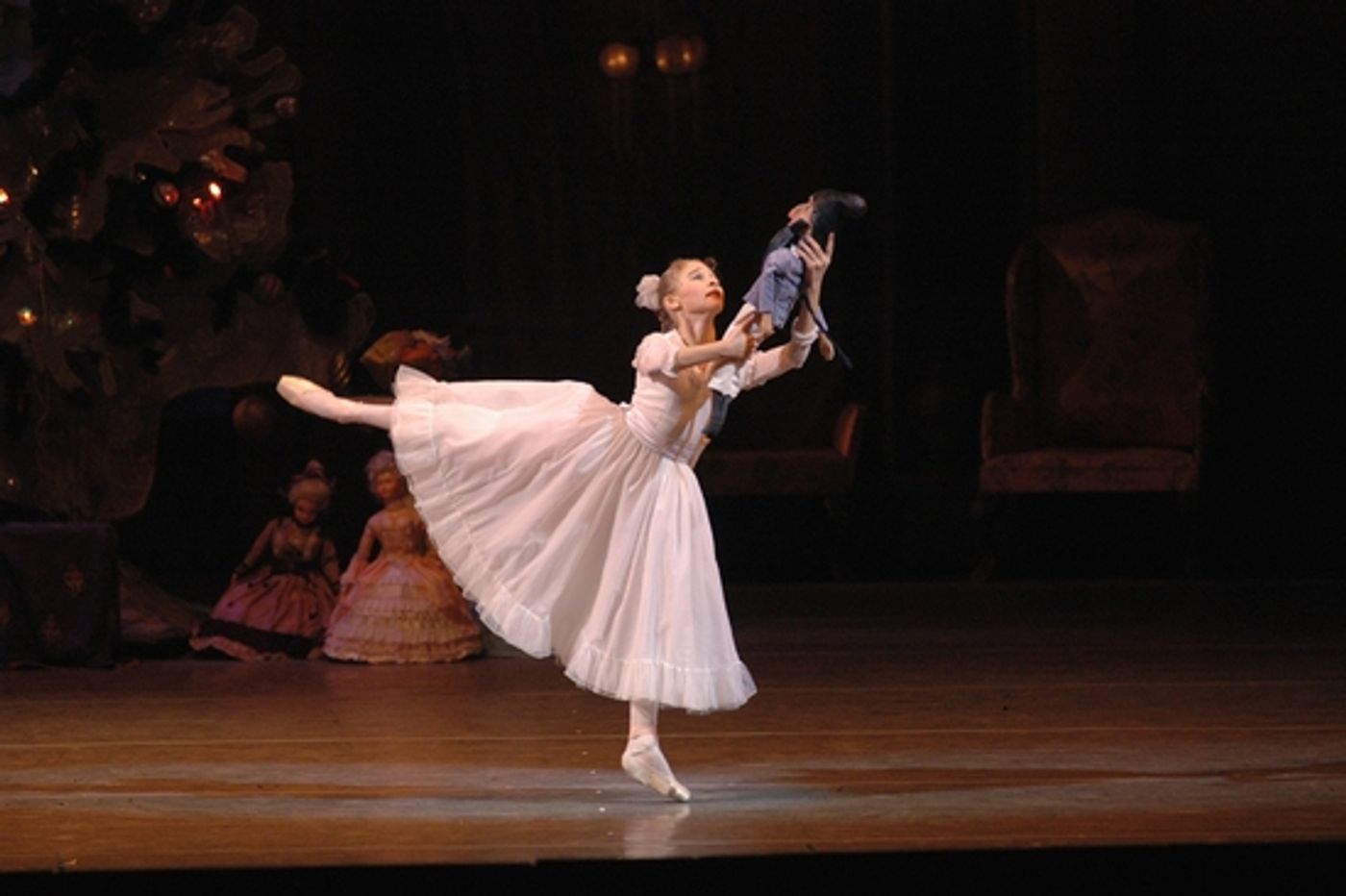Photo Flash: Kirov Ballet's The Nutcracker
The 2008-2009 season of Dance at the Music Center continues with a special, limited engagement of the Kirov Ballet and Orchestra of the Mariinsky Theatre's The Nutcracker, under the Artistic Direction of Valery Gergiev and Yury Fateev, Interim Director of the Ballet, to celebrate the holiday season for six performances only, December 17-20, 2008 at the Dorothy Chandler Pavilion.
The 200-year-old Kirov Ballet, under the Artistic Direction of Valery Gergiev since 1988, is one of the world's most renowned ballet companies. It performs the beloved, family holiday classic The Nutcracker, accompanied by a live orchestra, in a production filled with wonderment and child-like delight. The choreography, from 1934, is by Vasily Vainonen.
Over the four-day engagement, Evgenia Obraztsova, Irina Golub, and Ekaterina Osmolkina will dance the principal role of Masha. Vladimir Shkylarov, Alexander Sergeev, and Igor Kolb will dance the role of the Nutcracker Prince.
The history of The Nutcracker is a fascinating one. At the suggestion of the Board of Imperial Theatres, Marius Petipa wrote a scene plan for The Nutcracker in 1891; it was subsequently passed on to Pyotr Tchaikovsky. The subject was based on E.T.A. Hoffmann's famous tale "Nuβknacker und Mausekőnig," adapted for children and turned into a "ballet-féerie." The stage drama, however, proved to be limited for the symphonic conductor's imagination, and Tchaikovsky composed a symphonic ballet about childhood, life and fate, a striking picture of human emotions and of fantastic color.
The ballet was to be staged in 1892 by Lev Ivanov, the second ballet-master of the Mariinsky Theatre. His dance of the snowflakes was especially successful. The ballet was subsequently revived and remade, though it never matched the "fairytale and symphonic, orchestral and colourful nature of the score" (Boris Asafiev). Vasily Vainonen's production of 1934, however, upheld Petipa's traditions and pleased audiences with its warm and touching children's scenes, the beautiful dances of the snowflakes and the wonderful divertissement in the final act. The ballet is now staged using Vainonen's version and Simon Virsaladze's set designs from 1954.
Tickets for Kirov Ballet and Orchestra of the Mariinsky Theatre are priced from $30 - $120 and are available at the Dorothy Chandler Pavilion Box Office, 135 North Grand Avenue. Tickets are also available through Ticketmaster Phone Charge at (213) 365-3500 or (714) 740-7878, at all Ticketmaster Outlets and online at www.ticketmaster.com. For groups of 15 or more, call Connie Nelson at (310) 446-4398.
December 18, 2008, 2pm performance only - Come early!
From 12 p.m. - 1:30 p.m. kids of all ages can decorate their own cookie on the Music Center Plaza. Cost is $10 each and includes cookie, hot chocolate or apple cider. First come, first served. Tickets can be purchased at the box office the day of the event only.
For more information about this, and all Dance at the Music Center engagements, visit www.musiccenter.org.
About Kirov Ballet of the Mariinsky Theatre
St. Petersburg ballet is the collective result of the work of many years and many people within the Mariinsky Theatre. St. Petersburg ballet is almost as old as the city itself, and these centuries are made up of different epochs. In the 19th century, St. Petersburg ballet mainly spoke French. The century was split between the French choreographers Charles-Luois Didelot, Jules Perrot, Arthur Saint-Leon and Marius Petipa. Their Mecca was Paris, their tastes were cultivated by the Academy of Dance and the Grand Opera. St. Petersburg was the place where the harsh rules of an alien order receded, the rigid French school of dance being softened by the rhythmical Russian tendency towards sloth and the open vowels of the Russian language. These choreographers settled at the theatre for lengthy period, almost as if they were at home. "This is paradise!" exclaimed the young Petipa when he first came out of the Russian theatre director's office.
"Ballet Petersburg," the "St. Petersburg of ballet" was born - the same intangible, but indisputable phenomenon of cultural geography as the "St. Petersburg of Dostoevsky." And just as the "St. Petersburg of Dostoevsky" took shape in the form of Crime and Punishment or White Nights, so the "St. Petersburg of ballet" was represented by "The Sleeping Beauty," "Raymonda" and "La Bayadere."
In the 20th century, ballet spoke only in Russian. The century began with Michel Fokine's modernist revolution, and the 1920s saw the explosive burst of Fyodor Lopukhov's avant-garde. Later, high-level politics helped to suppress this influence: the country was fenced off from the world by the Iron Curtain. This was a death knell for many arts. But Leningrad ballet was able to maintain its high artistic standards, having become the focus of spiritual life for people of the time and even a unique kind of cultural Fronde. Petipa's ballets, the "gold reserves" of Russian choreography, remained as a source of nourishment for the greatest Soviet choreographers of pre-war Leningrad - Leonid Lavrovsky, Vasily Vainonen and Vakhtang Chabukiani. The grandiose dramatic ballets of pre-war Leningrad - "Romeo and Juliet," "The Fountain of Bakhchisarai," "Laurencia" and "Flame of Paris" - would not have been possible without 19th century ballet. Promoted by Soviet choreographers, only "psychological realism" was new. It had the effect of a magic spell for whole acuity and acting talents of Galina Ulanova, Tatiana Vecheslova, Alla Shelest, Konstantin Sergeyev, and the multitude of second and third rank dancers.
The whole company of the then Kirov Theatre was striking, from the ballerinas down to the last line of the corps de ballet. At the same time, first-class virtuoso dancers such as Natalia Dudinskaya, Feya Balabina, Vakhtang Chabukiani and Nikolay Zubkovsky permitted Leningrad ballet to preserve the glory of the most important RussIan Temple of classical dance.
The "new wave" of ballet evolved from a dispute, but to a still greater degree from the dialogue with the dramatic ballets of the late 1950s and early 1960s. The leading figures of the "new wave" were the young choreographers Yuri Grigorovich and Igor Belsky and the dancers Alla
Osipenko, Irina Kolpakova, Gabriela Komleva, Yuri Solovyev, Rudolph Nureyev, Natalia Marakova, and Mikhail Baryshnikov.
The "fathers" were referred to as "dramatic ballet" and the rebellious "children" as "symphonic ballet," but the combined tradition of succession preserved its power over both.
At the end of the 20th century, it learned to speak in English. Leningrad ballet once more started calling itself St. Petersburg ballet, but this time it went forth into the world. It started to perform works by 20th century Western choreographers such as Jerome Robbins, Kenneth MacMillan, Roland Petit, Anthony Tudor and John Neumeier which had previously been inaccessible, neglected during the years of forced Soviet isolation. But the main development is connected with the Russian-American choreographer George Balanchine: today, the repertoire of the Mariinsky Theatre contains almost as many ballets by Balanchine as by Petipa.
PHOTO CREDIT: The Nutcracker © The Kirov Ballet and Orchestra of the Mariinsky Theatre

The Nutcracker

The Nutcracker

The Nutcracker
Videos

